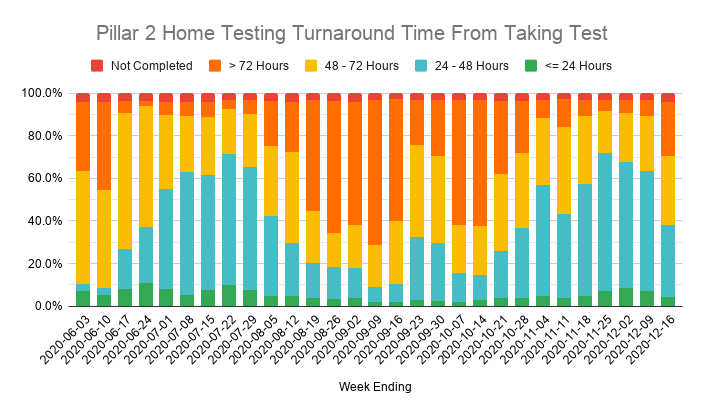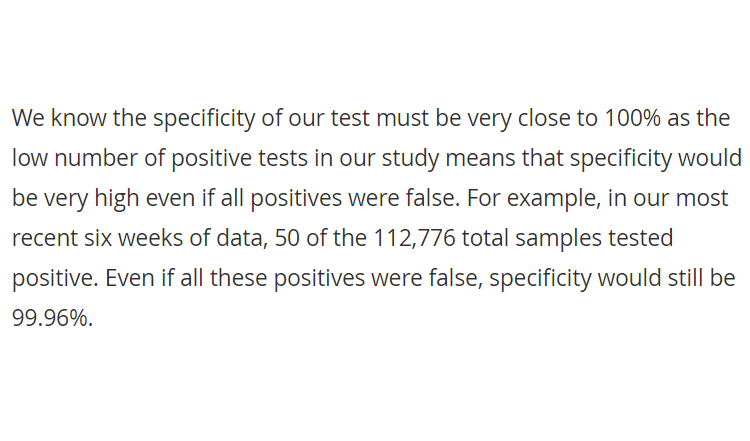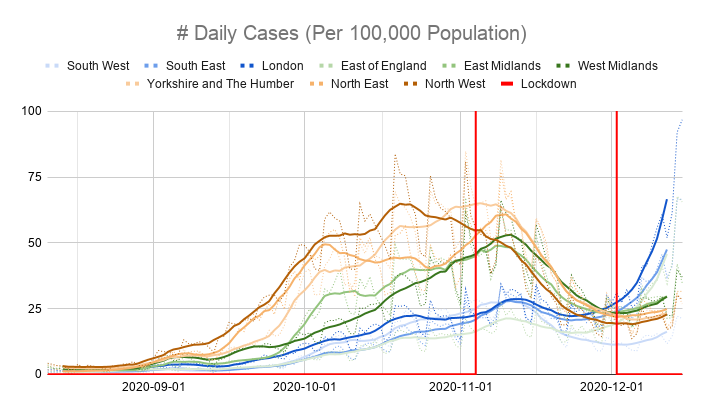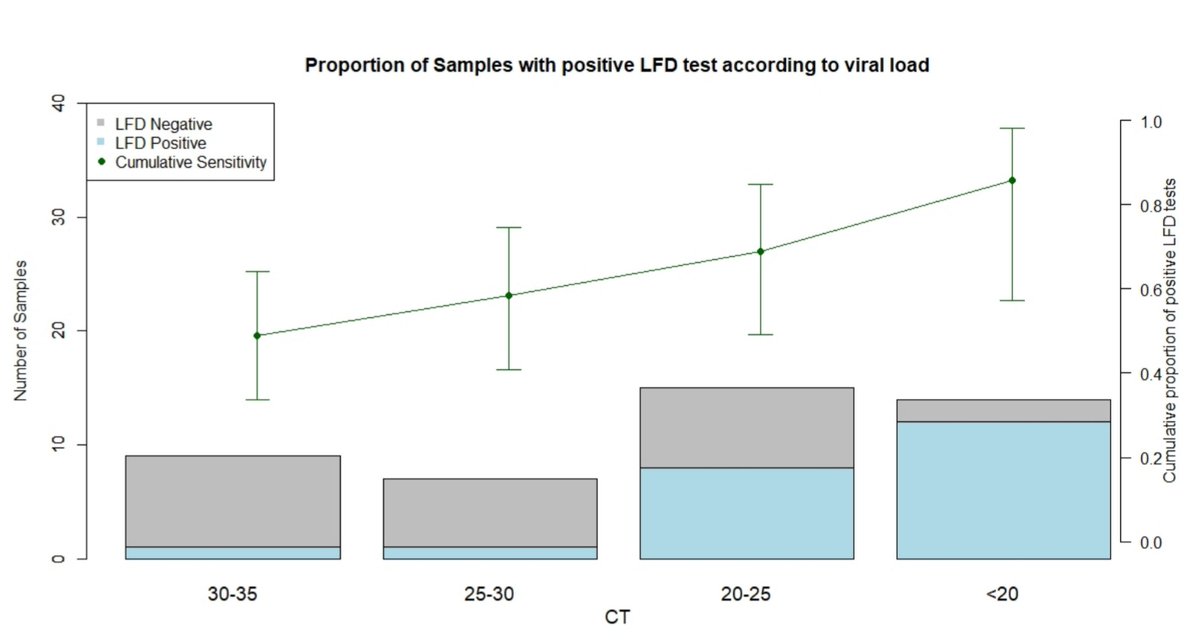
This week's Test & Trace report covers the week to December 16th, when cases in London and the South East were surging and falls in the North and Midlands levelling off.
There were also issues in the Lighthouse Lab system, apparently caused by a shortage of reagents.
There were also issues in the Lighthouse Lab system, apparently caused by a shortage of reagents.

As demand soared, almost 2 million tests were done in a week in England, which is amazing when you consider we struggled to test a few thousand people 9 months ago.
Despite this, the number of positive results rose much faster than testing, with positivity rates climbing again.



Despite this, the number of positive results rose much faster than testing, with positivity rates climbing again.




Breaking it down by type of test done:
The new Lateral Flow Tests are still only being used on people without symptoms, so positivity is very low but rose sharply this week.
Some (but not all) PCR tests are used on people with symptoms so have higher positivity. Over 10% again.
The new Lateral Flow Tests are still only being used on people without symptoms, so positivity is very low but rose sharply this week.
Some (but not all) PCR tests are used on people with symptoms so have higher positivity. Over 10% again.

Meanwhile there's still a weird issue with data for Pillar 1 (hospital) tests in the week to November 4th, particularly in Hammersmith & Fulham.
Another 16,703 tests have been added to the total in the latest report, on top of 99,252 in previous revisions. Almost all in London.
Another 16,703 tests have been added to the total in the latest report, on top of 99,252 in previous revisions. Almost all in London.

There have been big revisions to data for that week in every report since.
Hammersmith & Fulham now reports doing 4 times as many tests that week as any other before or since!
It's not clear if this is an error, and if not why it's taking months to identify all the tests done.
Hammersmith & Fulham now reports doing 4 times as many tests that week as any other before or since!
It's not clear if this is an error, and if not why it's taking months to identify all the tests done.

The only possible explanation I've found is that during that week 24 staff had to self-isolate after being in close contact with two patients admitted to ICU for non-covid ailments who later tested positive.
Did they screen everyone after that?
londonnewsonline.co.uk/24-staff-membe…
Did they screen everyone after that?
londonnewsonline.co.uk/24-staff-membe…
Coming back to the latest week, there's a dip in performance for Pillar 2 labs, after several weeks of steady improvements in test turnaround times.
Only 34% of "in person" tests gave a result within 24 hours of taking the test, compared to 65% at the end of November.



Only 34% of "in person" tests gave a result within 24 hours of taking the test, compared to 65% at the end of November.




There are similar issues with turnaround times for Home and Satellite (care home) testing.
This means average turnaround times are up on last week by a few hours for every type of Pillar 2 PCR test.



This means average turnaround times are up on last week by a few hours for every type of Pillar 2 PCR test.




There was also a jump in the number of tests that hadn't delivered a result yet when the report was compiled, from 21,433 to 33,065.
Although as the number of tests done was also much higher this week, it's a fairly small increase in terms of the percentage of incomplete tests.
Although as the number of tests done was also much higher this week, it's a fairly small increase in terms of the percentage of incomplete tests.

This is likely to be connected to a recent shortage of supplies such as chemical reagents needed to process the tests, which forced the Milton Keynes lab (at least) to cut working hours for their staff, just as demand for testing was rising rapidly.
bylinetimes.com/2020/12/21/uk-…
bylinetimes.com/2020/12/21/uk-…
The contact tracing system seems to have held up well in the face of the sudden spike in demand though.
88% of new cases that were transferred to the contact tracing system were reached, which is a new record, and mostly within 24 hours of referral.



88% of new cases that were transferred to the contact tracing system were reached, which is a new record, and mostly within 24 hours of referral.




Now that people who test positive are asked to tell everyone in their household to self-isolate, most household contacts count as "reached".
But with less time spent on repeat calls to the same home, 70% of non-household contacts were reached too, which is the best for 3 months.



But with less time spent on repeat calls to the same home, 70% of non-household contacts were reached too, which is the best for 3 months.




While recent improvements in the system are welcome, we need to get cases down again for contact tracing to be effective.
And it's all pointless if 89% of contacts don't self-isolate! Research suggests many don't understand why they need to stay at home.
medrxiv.org/content/10.110…
And it's all pointless if 89% of contacts don't self-isolate! Research suggests many don't understand why they need to stay at home.
medrxiv.org/content/10.110…
Messaging clearly needs to be improved (if it hasn't already).
10% of people said they didn't realise they needed to stay at home, 12% didn't self-isolate because they didn't have symptoms at the time, and 10% went out to help a vulnerable person .. who they could have infected!
10% of people said they didn't realise they needed to stay at home, 12% didn't self-isolate because they didn't have symptoms at the time, and 10% went out to help a vulnerable person .. who they could have infected!

This is also maybe somewhere lateral flow tests could be useful?
If most people reached by contact tracers aren't going to stay at home anyway, testing them every day during that period might be more effective, as long as it's clear they don't guarantee you don't have the virus.
If most people reached by contact tracers aren't going to stay at home anyway, testing them every day during that period might be more effective, as long as it's clear they don't guarantee you don't have the virus.
Improving support for people told to self-isolate would also help.
The recent Liverpool mass testing trial found that people in poorer areas were far less likely to get tested, because they couldn't afford to self-isolate if they tested positive.
The recent Liverpool mass testing trial found that people in poorer areas were far less likely to get tested, because they couldn't afford to self-isolate if they tested positive.
https://twitter.com/_johnbye/status/1342252457766903810?s=20
The study on adherence to testing and self-isolation guidance was done in September, but it's not clear if changes since then have improved the figures at all.
And this is really something that should have been done months ago, as numbers have been consistently dire since March.
And this is really something that should have been done months ago, as numbers have been consistently dire since March.
This week's Test & Trace report and accompanying data can be found here, although over Christmas the reports are going to be fairly skinny.
gov.uk/government/pub…
gov.uk/government/pub…
And here's my analysis of last week's report for comparison.
https://twitter.com/_johnbye/status/1340618607022268418?s=20
• • •
Missing some Tweet in this thread? You can try to
force a refresh












